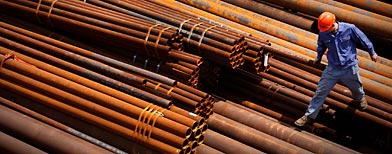Short term, China will keep growing rapidly, adding to demand and boosting the global economy. Long term, the picture’s not so pretty.
China’s economy is slowing, but only a little. The July industrial production numbers announced by the country’s National Bureau of Statistics on Aug. 11 were weaker than expected. That raised fears that one of the engines of global growth was about to seize up. In fact, the slight slowdown is intentional, the result of moves by Beijing to prevent overheating. China can and will change course if the need arises. We still expect it to grow about 10% this year, a figure that will make most of the world envious.

Double-digit annual GDP gains in the past were relatively easy because the economy was growing from a small base. Those kinds of gains will be harder to achieve now that China is the world’s second largest economy, about one-third the size of the U.S. But China’s lightning expansion also masks a host of serious structural flaws. Fixing them will take major reforms that, so far, Beijing has proved unwilling to make — in no small part because they would undermine the authority of the ruling Communist Party.
Still, over the next few years, Chinese growth has to moderate somewhat.
Excessive Capital Investment
Beijing rewards provincial and local government officials with promotions if they manage their regions well. For decades, the chief measure of progress was success in providing jobs for a rapidly growing urban workforce. That usually meant building factories or adding infrastructure, whether needed or not. Such overcapacity leads to waste of scarce resources, deflation and dumping of excess production abroad.
Financial Mismanagement
Local officials force state-owned banks to finance that construction at next-to-nothing rates, with no regard for borrowers’ suitability. Inevitably, nonperforming loans pile up on the banks’ balance sheets. Beijing already recapitalized the four largest state banks once, forcing ordinary depositors to foot the bill, which hurt consumption. Now bad loans are once again on the rise, a result of the $586-billion stimulus China poured through banks last year. Though Beijing could manage another bailout, it certainly can’t go through this cycle endlessly.
Flawed Education
Chinese colleges graduate many times the number of engineers and scientists that American universities produce, but such statistics are misleading. To meet the quotas for graduates set by Beijing, academic programs dilute their standards. They further inflate their count by counting as engineering students those studying to become mechanics or industrial technicians. The result, according to a pioneering study led by Duke University professors Gary Gereffi and Vivek Wadhwa, is that many of these graduates fall far short of the standards imposed by U.S. colleges and universities. When they graduate, many are unable to find work in their professions.
Stifled Innovation
Those engineers and scientists who do measure up — the cream of Chinese universities or those who study overseas and return home — often have little freedom to explore. If they work for state-owned firms or universities, Beijing dictates the direction of research and development. Many gravitate to the more open atmosphere at private firms, but these companies can’t get loans to grow because state enterprises gobble up the capital. Beijing aims to compensate by forcing multinationals to transfer advanced technology as the cost of doing business in China, but foreign firms are fighting back hard.
Environmental Degradation
Water pollution and water shortages pose the most serious problems. They cause health ailments, damage agriculture, jam up hydroelectric dams, interfere with manufacturing and limit urbanization. As aquifers dry up, soil erodes, turning an area the size of Connecticut to desert every year. The resulting dust storms add to the country’s already horrendous air pollution. Beijing’s preferred solution to the problem is a massive south-to-north river diversion project. Odds are, that will make matters worse, draining water from already overtaxed southern supplies.
Corruption
One of the major reasons Beijing has such a hard time dealing with all the problems mentioned above is that so many individuals have a vested interest in keeping things exactly as they are. Communist Party officials pay for their advancement, then aim to earn back their investment. Local governments seize houses and land, sell it to developers with little compensation for those displaced, then take kickbacks from the construction companies. Academics provide kickbacks to the party in exchange for research funding. U.S. companies operating in China suffer as well. “When U.S companies hire for research and development there, there’s a lot of pressure to put Communist Party members in key positions,” says Wadhwa.
Beijing does make examples of particularly corrupt officials and business leaders, sometimes even executing the offenders. But the problem of corruption is endemic, says Liao Ran, a China specialist with Transparency International. “Generally speaking, the cost of corruption amounts to about 10% to 13% of annual GDP,” he says. In absolute terms, that’s a loss of $500 billion to $700 billion per year.
And Demographics
As the generation of the Cultural Revolution retires, the burden of their care falls heavily on the smaller generation of the one-child policy. “The Chinese population is simply growing older faster than it’s getting richer,” says Peter Navarro, a professor of economics and public policy at the University of California at Irvine. As fewer workers support more retirees, competitiveness will suffer. For an illustration of what this could mean, China need look no farther than Japan.
Andrew C. Schneider, Associate Editor, The Kiplinger Letter










































